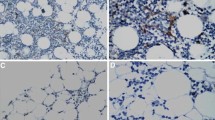Abstract
Acute myeloid leukemia (AML) is a clonal disorder characterized by abnormal proliferation of myeloid cell precursors. Research has mainly focused on the cellular events, but the bone marrow matrix has attracted minor interest. In this study bone marrow biopsies were obtained from 35 newly diagnosed AML patients. The bone marrows were analyzed regarding the occurrence and distribution of hyaluronan (HYA) and reticulin fibers (type III collagen). The bone marrow sections were analyzed histochemically and compared with bone marrows from 30 healthy controls. The HYA staining was significantly stronger in the AML patients compared with the controls. Only one patient demonstrated abnormal reticulin staining score, but in the group of patients with antecedent myelodysplastic syndrome (MDS), the reticulin staining score was significantly higher compared with the patients with de novo AML. There was a significant correlation between the HYA staining and reticulin staining scores in the AML patients as was seen in the control group.
Similar content being viewed by others
References
Turley E, Noble P, Bourguignon L. Signaling properties of hyaluronan receptors. J Biol Chem 2002;277(7):4589–4592.
Horton M, et al. Hyaluronan fragments synergize with interferon to induce the C-X-C chemokines Mig and interferon-inducible protein-10 in mouse macrophages. J Biol Chem 1998;273(52):35088–35094.
Turley E. Purification of a hyaluronate-binding protein fraction that modifies cell social behavior. Biochem Biophys Res Commun 1982;108:1016–1024.
Underhill C. CD44: The hyaluronan receptor. J Cell Sci 1992;103:293–298.
Greiner J, et al. Characterization of several leukemia-associated inducing humoral immune responses in acute and chronic myeloid leukemia. Internat J Cancer 2003;106:224–231.
Ponta H, Sherman L, Herrlich P. CD44: From adhesion molecules to signaling regulators. Nature 2003;4:33–45.
Charrad R-S, et al. Ligation of the CD44 adhesion molecule reverses blockage of differentiation in human acute myeloid leukemia. Nature 1999;5(6):669–676.
Politz O, et al. Stabilin-1 and-2 constitute a novel family of fasciclin-like hyaluronan receptor homologues. Biochem J 2002;362:155–164.
Islam A. Proposal for a classification of acute myeloid leukaemia based on plastic-embedded bone marrow biopsy sections. Leukemia Res 1993;17:421–427.
Jaffe E, Harris N, Stein H, Vardiman J. (eds). World Health Organization Classification of Tumours. Pathology and genetics of tumours of haematopoetic and lymphoid tissues. IARC Press, Lyon, France, 2001, pp. 76–80.
Sundström G, Löfvenberg E, Hassan I, Engström-Laurent A. Localisation and distribution of hyaluronan in normal bone marrow matrix: a novel method to evaluate impending fibrosis? Eur J Haematol 2002;68:194–202.
Bain BJ, Clark DM, Lampert IA. Bone marrow pathology. Blackwell Science: Oxford, 2001.
Putt FA. Manual of histological staining methods. John Wiley & Sons: New York, 1972, p. 107.
Tengblad A. Affinity chromatography on immobilized hyaluronate and its application to the isolation of hyaluronate binding proteins from cartilage. Biochim Biophys Acta 1979;578:281–289.
Hellström S, Tengblad A, Johansson C, Hedlund U, Axelsson E. An improved technique for hyaluronan histiochemistry using microwave irradiation. Histochem J 1990;22:677–682.
Bauermeister DE. Quantitation of bone marrow reticulin—a normal range. Am J Clin Pathol 1971;56:24–31.
Avigdor A, et al. CD44 and hyaluronic acid cooperate with SDF-1 in the trafficking of human CD34+ stem/progenitor cells to bone marrow. Blood 103(8):2981–2989.
Midura RJ, Xiaowei S, Morcuende JA, Tammi M, Tammi R. Parathyroid hormone rapidly stimulates hyaluronan synthesis by periosteal osteoblasts in the tibial diaphysis of the growing rat. J Biol Chem 2003;51(278):51462–51468.
Hellström M, Mattsson C, Hellström S, Engström-Laurent A. Hyaluronan is differently located in arteries and veins. An immunohistochemical study in the rat. Cells Tissues Organs 2003;173:227–233.
Nilsson S, et al. Hyaluronan is synthesized by primitive hemopoetic cells, participates in their lodgment at the endosteum, following transplantation, and is involved in the regulation of their proliferation and differentiation in vitro. Blood 2003;101:856–862.
Li L, et al. Reconstitution of CD40 and CD80 in dendritic cells generated from blasts of patients with acute myeloid leukemia. Cancer Immunity 2003;3:8–19.
Author information
Authors and Affiliations
Corresponding author
Rights and permissions
About this article
Cite this article
Sundström, G., Dahl, I.M.S., Hultdin, M. et al. Bone marrow hyaluronan distribution in patients with acute myeloid leukemia. Med Oncol 22, 71–78 (2005). https://doi.org/10.1385/MO:22:1:071
Received:
Accepted:
Issue Date:
DOI: https://doi.org/10.1385/MO:22:1:071




